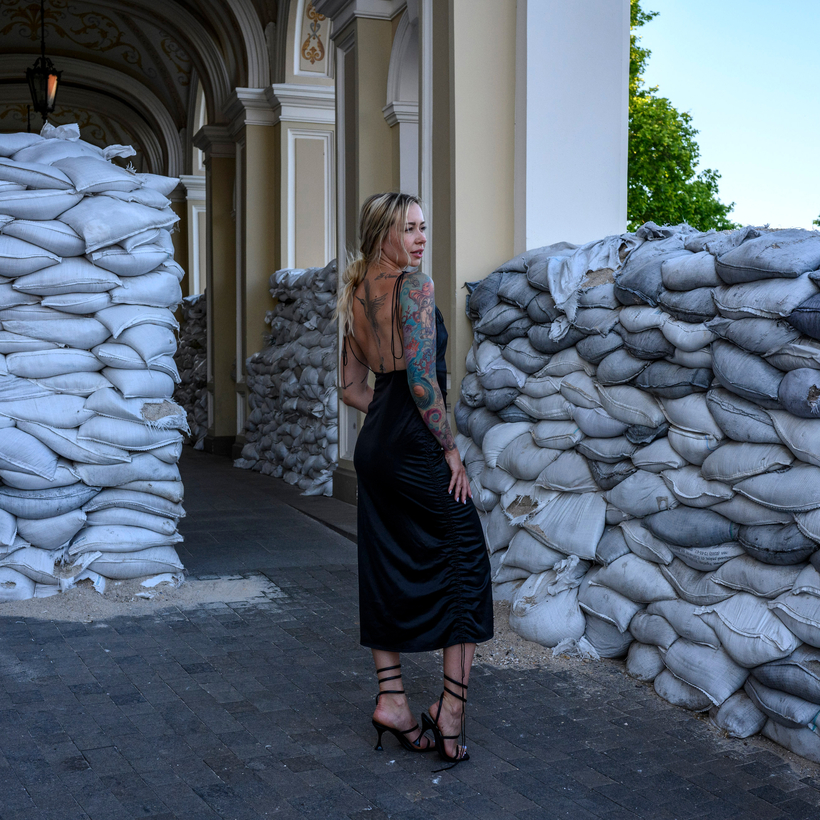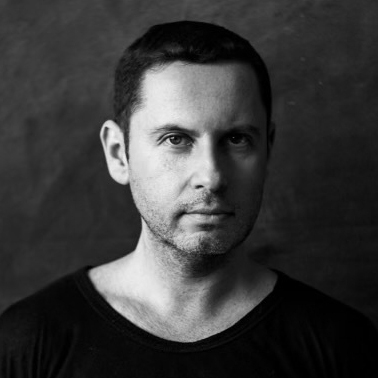As his native Kyiv was being bombed by the Russians in the early days of the war, Oleksandr Trotsyuk did as many others did: he ducked out for food in between air-raid sirens, checked on his loved ones, and tried to maintain contact with the outside world in a situation that felt both unreal and all too real. There was little time to work on Object X, the line of tech wear he was designing, whose founder had left to fight on the front lines. But despite the horror of being in a war zone, and as frivolous as it seemed, fashion was still on his mind.
Trotsyuk fell in love with fashion as a teenager in the late 90s, as post-Soviet Ukraine was opening up to Western cultural influence and dressing up came to signify upward mobility and a newfound sense of optimism. Like many obsessives who have limited access to fashion, Trotsyuk resorted to the means he had at his disposal. Back then that meant trawling a nascent market for donated clothing that came from Western Europe, an industry that has only expanded through the years and continues to thrive today despite the war.
While most American castoffs end up in Africa, it is cheaper for Western European countries to offload them onto Ukraine, a country with nearly 37 million people and a penchant for dressing up. The bulk shipments of unwanted clothes, footwear, and accessories are routed via logistics networks run by Iranian and Pakistani immigrants, who purchase the clothes by weight and send them on to Ukraine.

The contents of shipments have no rhyme or reason—they could be worn-out fast fashion or pristine designer clothes from the likes of Dior, Balenciaga, and Helmut Lang. And although some of the garments that end up in Ukraine are brand-new, with tags, this industry is known there as “secondhand.”
The market for these clothes in Ukraine closely mirrors what’s fashionable around the globe. For young men, it’s elevated streetwear: Italian brands Stone Island and C.P. Company, equally popular with rappers and rabid English soccer fans, are highly coveted, and so are limited-edition sneakers from Nike, Jordan, and Adidas. For the older clientele, Brunello Cucinelli and Burberry remain perennially in demand.
Just as in the rest of the world, celebrities, especially the Kardashians, exert outsize influence. According to Trotsyuk, when Kim Kardashian wore a brown North Face puffer in public some years ago, their prices went through the roof (meaning they sold in Ukraine for $100 each).
Even as the fight against Russia rages on, there seems to be enough good clothing to sustain a cottage industry of online resellers, with intense competition. Enterprising young men and women use the Internet to glean a sense of what’s in demand and then sell accordingly. And in a new twist in the secondhand plot, resellers now sell their finds back to the West. Thanks to Web sites such as Grailed and Depop, skilled resellers in Ukraine can make 10 to 50 times more than what they paid at second hand, as I have recently found out myself when I bought a rare T-shirt from a cult designer, Yang Li, on Grailed. It was shipped to me from Ukraine.

In the late 90s the Internet was virtually nonexistent in Ukraine, and kids ravenous for Western culture and fashion got their clues from TV and whatever Western magazines trickled down to the newsstands. It was an education, certainly, but digging through the large wooden tables of Western castoffs for hours was how Trotsyuk and his contemporaries really honed an eye for quality clothing.
If one was lucky, one could score a pair of Levi’s or Armani jeans for 50 cents. “Five dollars could build you a wardrobe for a month,” Trotsyuk tells me over a video call from his home in Kyiv. His first luxury-designer score was a pair of Dior boots that he bought for $11. Next was a pair of Helmut Lang jeans for two bucks. Without knowing what Supreme was, he bought a parka for 20 cents because he liked the material and the chunky metal zipper. His father’s friend still wears it.
To Trotsyuk and enthusiasts like him—long on passion but short on cash—the secondhands offered a lifeline. “You were poor, but you felt good about being able to dress well or treat your girlfriend,” he says.
Despite the horror of being in a war zone, and as frivolous as it seemed, fashion was still on his mind.
By 2008, a middle class was taking shape in Ukraine, but that year’s global financial crisis hit the country hard. Its currency, the hryvnia, lost 40 percent of its value against the dollar, and the secondhand-garment business exploded. “At that point you could buy a couple of sandwiches, or you could buy a pair of pants,” says Trotsyuk.
Ukraine was producing garments for big brands such as Armani and Hugo Boss, and even for more niche, fashion-forward designers such as Comme des Garçons and Mugler. Ironically, few Ukrainians could afford them. That is, unless those garments circled back via the secondhand markets.
The markets also proved to be indispensable to fashion enthusiasts. “Quite a few Ukrainian fashion designers learned about fashion from the secondhands,” says Trotsyuk.
Lilia Litkovska, the Ukrainian fashion designer who shows her brand, Litkovska, in Paris, explains that secondhands were not just a consumer good—they were a sort of substitute for fashion school. “The secondhands were an indispensable education not only in dressing but also in materials and construction,” she says. Like Trotsyuk, Litkovska did not have a formal education in fashion. “I was buying what looked interesting,” she says.

Ukraine slowly recovered from the financial crisis only to go through another one when Russia invaded in 2014. The hryvnia crashed again, putting prosperity out of reach for most people. The secondhand markets continued to boom, but now they were more organized, with clothes sorted and hung on racks—resellers opened shops where they resold their secondhand scores at a markup.
More discarded fashion was sent abroad as the West’s appetite for fashion increased. Now nearly every sizable city in Ukraine has a secondhand market, sometimes housed in hangars as large as a football field. And as the market has expanded, humanitarian chains such as Humana People to People, which reportedly has more than 100 secondhand stores in Ukraine (though they declined to confirm that figure when reached for comment), have become part of the industry.
Not everyone in Ukraine is optimistic about it, though. “There is an incredible amount of stuff that is being sent here as humanitarian aid that is pretty much trash,” says Venya Brykalin, the editor of Vogue Ukraine. “The question is what is our country supposed to do with the mountains of unsellable clothes?” Regardless, the flood of Western castoffs continues unabated.
It may seem strange to be preoccupied with the way you look during such a time, but life does not stop, and it’s things like these that give many Ukrainians a semblance of normalcy. “The secondhands allow access to good clothes to those who cannot normally afford them,” says Trotsyuk.
Busy with his job and leaving the hunting to the next generation, Trotsyuk has become the end customer himself. Recently, he bought a vintage Helmut Lang silk suit in mint condition for less than $100.
“The guy who sold it to me probably bought it for 10 bucks,” he said.
Eugene Rabkin is the founder and editor of StyleZeitgeist and the author of Stone Island: Storia. His work has appeared in The New York Times, The Business of Fashion, and other publications


